Recent Water Damage Posts
Preparing Your Home for Summer Storms | SERVPRO of Pueblo
8/30/2024 (Permalink)
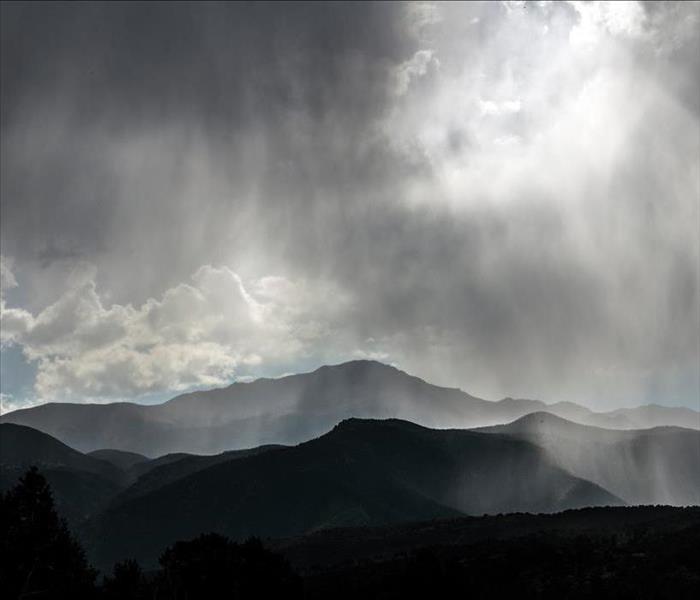 When storms strike your Colorado property, call SERVPRO of Pueblo to resolve any damage fast!
When storms strike your Colorado property, call SERVPRO of Pueblo to resolve any damage fast!
Late summer storms can bring heavy rain and intense winds, posing a significant risk of water damage to your home. To mitigate these risks, it's crucial to take proactive steps in preparing your property. Start by inspecting your roof for any missing or damaged shingles. A compromised roof can easily let water seep into your home, leading to potential leaks and damage.
Additionally, ensure that your gutters and downspouts are clean and functioning correctly. Clogged gutters can cause water to overflow, potentially damaging your foundation and exterior walls. By maintaining these critical components, you can help prevent water from finding its way into your home.
Address Common Vulnerabilities
Beyond roofing and gutters, there are other areas in your home that require attention to reduce the risk of water damage. Check for cracks or gaps around windows and doors, as these can allow water to enter during heavy rainfall. Properly sealing these openings with weather-resistant caulk can make a significant difference. It's also wise to examine your home's foundation for any signs of cracks or leaks.
Small fissures can expand over time, leading to substantial water infiltration if not addressed promptly. Installing sump pumps in your basement or crawl space can help manage excess water and prevent flooding. These steps collectively contribute to safeguarding your home against the unpredictable nature of late summer storms.
Create an Emergency Plan
Even with the best preventive measures, it's essential to be prepared for the possibility of water damage. Develop an emergency plan that includes identifying and locating shut-off valves for your water supply, which can be crucial if a pipe bursts or a leak occurs. Keep important documents and valuables in waterproof containers or elevated areas to protect them from potential water exposure.
Additionally, consider investing in a battery-powered weather radio or weather app to stay informed about storm alerts and conditions. Having an emergency plan in place ensures that you can respond quickly and effectively if water damage does occur, minimizing its impact on your home and belongings.
If you experience water damage from late summer storms or any other cause, SERVPRO of Pueblo is Here to Help®. Our team of experts is available 24/7 to provide rapid and reliable water damage restoration services.
Don’t wait until it's too late—take these preventive steps now and contact us to ensure your home is protected. For immediate assistance and expert guidance, reach out to SERVPRO of Pueblo today. Let us help you safeguard your home and restore peace of mind.
5 Essential Tips to Mitigate Flooding Risks in Pueblo, Colorado
5/18/2024 (Permalink)
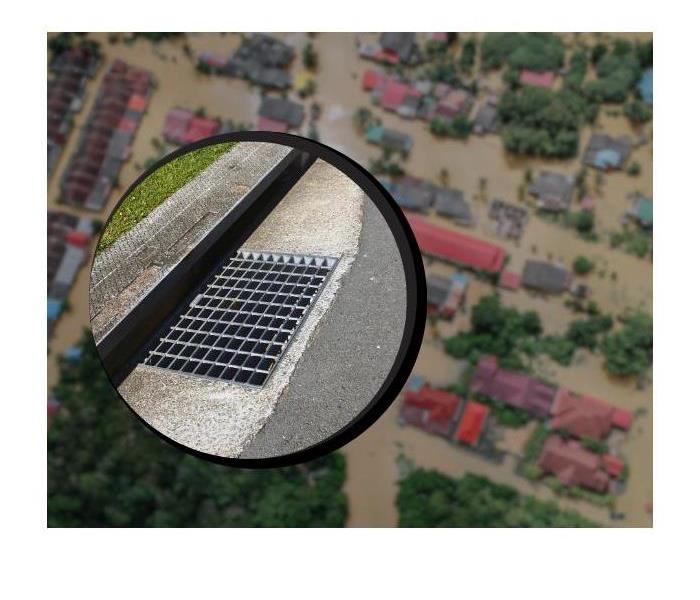 Mitigate Flooding Risks in Pueblo, Colorado
Mitigate Flooding Risks in Pueblo, Colorado
Pueblo, Colorado, nestled at the confluence of the Arkansas River and Fountain Creek, is a vibrant city known for its rich history, diverse culture, and stunning natural landscapes. However, like many cities situated near water bodies, Pueblo is not immune to the threat of flooding. With the increasing frequency and intensity of extreme weather events attributed to climate change, it's crucial for residents and authorities alike to take proactive measures to reduce flooding risks and safeguard lives and properties. In this blog post, we'll explore five essential tips to mitigate flooding risks in Pueblo, Colorado.
1. Stay Informed and Prepared:
Knowledge is power when it comes to dealing with flooding risks. Stay informed about weather forecasts, river levels, and flood alerts issued by local authorities. Sign up for emergency notifications and heed evacuation orders if necessary. Develop a comprehensive emergency plan for your family or business, including evacuation routes, emergency contacts, and essential supplies like food, water, medications, and important documents. Being prepared can make a significant difference in how well you can navigate through a flooding event and ensure the safety of your loved ones.
2. Invest in Flood Insurance:
Many homeowners mistakenly believe that their standard homeowner's insurance policy covers flood damage. However, most policies exclude flood damage, leaving homeowners vulnerable to substantial financial losses. To protect your investment and mitigate financial risks associated with flooding, consider purchasing flood insurance through the National Flood Insurance Program (NFIP) or private insurers. Flood insurance can provide coverage for building structures and contents, helping you recover more quickly and effectively in the aftermath of a flood. Consult with an insurance agent to determine the appropriate coverage for your property and budget.
3. Implement Stormwater Management Practices:
Effective stormwater management is critical for reducing flooding risks in urban areas like Pueblo. Stormwater runoff from heavy rainfall can overwhelm drainage systems, leading to flash floods and property damage. Implementing stormwater management practices, such as installing rain gardens, permeable pavements, and green roofs, can help absorb and infiltrate rainwater, reducing the volume of runoff and alleviating pressure on drainage infrastructure. Additionally, maintaining and cleaning gutters, downspouts, and storm drains regularly can prevent blockages and ensure proper water flow away from your property.
4. Promote Natural Floodplain Functions:
Recognizing the ecological value of floodplains and restoring their natural functions can play a significant role in reducing flooding risks in Pueblo. Floodplains act as natural buffers that absorb excess water during heavy rainfall and help mitigate downstream flooding. Protecting and restoring floodplain areas through land-use planning, conservation easements, and green infrastructure projects can enhance their capacity to store and slow down floodwaters, reducing the severity of flooding events and protecting downstream communities. Encourage local policymakers and developers to prioritize floodplain preservation and restoration efforts to enhance community resilience to flooding.
5. Participate in Community Flood Mitigation Efforts:
Flooding is a community-wide issue that requires collective action and collaboration to address effectively. Get involved in community flood mitigation efforts by joining local watershed groups, neighborhood associations, or volunteer organizations dedicated to flood risk reduction and resilience building. Participate in floodplain mapping and hazard mitigation planning processes to contribute valuable insights and expertise to community decision-making. By working together with fellow residents, businesses, and government agencies, you can advocate for sustainable flood management strategies, secure funding for flood mitigation projects, and strengthen community resilience to flooding over the long term.
In conclusion, reducing flooding risks in Pueblo, Colorado, requires a multifaceted approach that combines individual preparedness, infrastructure improvements, ecosystem restoration, and community engagement. By staying informed, investing in flood insurance, implementing stormwater management practices, promoting natural floodplain functions, and participating in community flood mitigation efforts, residents and authorities can work together to mitigate the impacts of flooding and create a safer, more resilient city for future generations. Let's take proactive steps today to build a more flood-resilient Pueblo tomorrow.
Dealing with Water Damage from a Leaking Toilet and the Role of SERVPRO of Pueblo in Restoration
1/15/2024 (Permalink)
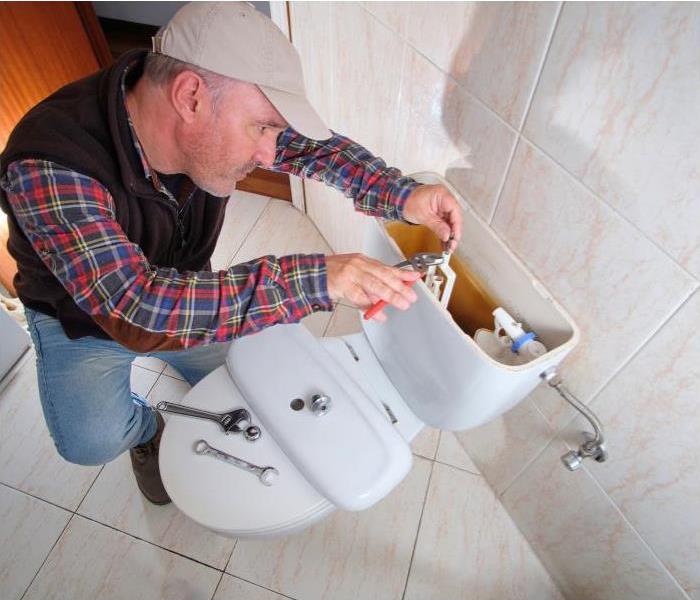 Leaking Toilet in Pueblo, Colorado.
Leaking Toilet in Pueblo, Colorado.
Water damage is a homeowner's nightmare, and a leaking toilet can quickly escalate into a major problem if not addressed promptly. Whether it's a slow, persistent leak or a sudden burst, water damage can wreak havoc on your home, causing structural issues, mold growth, and damage to personal belongings. In this blog, we will explore practical tips for dealing with water damage from a leaking toilet and highlight the invaluable assistance offered by SERVPRO of Pueblo in mitigating and restoring your home.
Identifying the Leak
The first step in addressing water damage from a leaking toilet is identifying the source of the leak. Leaks can occur in various places, such as the tank, bowl, supply line, or wax ring. Check for visible signs of water around the base of the toilet, on the floor, or dripping from the tank or bowl. A running toilet or unusual sounds during flushing can also indicate a problem. Once you've identified the source, turn off the water supply to the toilet to prevent further damage.
Quick Action is Key
Time is of the essence when dealing with water damage. The longer water sits, the greater the potential for structural damage and mold growth. Begin by removing excess water using towels, mops, or a wet/dry vacuum. Wipe down surfaces to prevent water absorption and promote drying. If the water damage is extensive, consider using a dehumidifier to reduce humidity levels in the affected area.
Remove Damaged Items
Personal belongings and furniture in the affected area should be promptly removed to prevent further damage. Upholstered furniture, carpets, and rugs are particularly susceptible to water absorption and can harbor mold if not addressed promptly. If possible, move items to a dry area or elevate them to allow air circulation. SERVPRO of Pueblo can assist in the assessment and removal of damaged items, utilizing their expertise in water damage restoration.
Thoroughly Dry the Area
After removing excess water and items, focus on thoroughly drying the affected area. Open windows and doors to promote ventilation and use fans to expedite the drying process. If the water damage is extensive, professional-grade drying equipment may be necessary to ensure that hidden pockets of moisture are addressed. SERVPRO of Pueblo employs advanced drying techniques and equipment to achieve optimal results, preventing long-term damage and mold growth.
Addressing Flooring and Walls
Flooring and walls are particularly vulnerable to water damage. In the case of hardwood floors, prompt removal of water and thorough drying are crucial to prevent warping and irreversible damage. Similarly, drywall can absorb water and become a breeding ground for mold if not addressed promptly. SERVPRO of Pueblo specializes in water damage restoration, including the repair and replacement of flooring and walls, ensuring a comprehensive restoration process.
Inspect and Repair Plumbing
Once the immediate water damage has been addressed, it's essential to inspect and repair the plumbing issue causing the leak. This may involve tightening loose connections, replacing faulty parts, or even repairing or replacing damaged pipes. If you are uncertain or uncomfortable with plumbing repairs, it is advisable to seek the expertise of a professional plumber. SERVPRO of Pueblo can also assist in coordinating plumbing repairs as part of their comprehensive restoration services.
Professional Assessment and Restoration with SERVPRO of Pueblo
While the initial steps in dealing with water damage are crucial, the expertise of a professional restoration service like SERVPRO of Pueblo is invaluable in ensuring a thorough and effective restoration process. SERVPRO's team of trained technicians possesses the knowledge, experience, and advanced equipment needed to assess the extent of the damage and implement a comprehensive restoration plan.
SERVPRO of Pueblo follows a systematic approach to water damage restoration:
Assessment: A thorough evaluation of the extent of water damage is conducted, including identifying hidden pockets of moisture using specialized equipment.
Extraction: Advanced extraction equipment is used to remove excess water from the affected area, preventing further damage.
Drying: High-powered air movers and dehumidifiers are deployed to dry the area completely, ensuring that all moisture is eliminated.
Cleaning and Sanitizing: The affected area is cleaned and sanitized to prevent mold growth and ensure a safe living environment.
Restoration: SERVPRO of Pueblo provides comprehensive restoration services, including repairs to flooring, walls, and other structural elements. The goal is to return your home to its pre-damage condition.
Dealing with water damage from a leaking toilet requires a prompt and systematic response to minimize the potential for long-term damage. While initial steps such as identifying and addressing the source of the leak are crucial, the expertise of professionals like SERVPRO of Pueblo is instrumental in ensuring a thorough and effective restoration process. By following the tips outlined in this blog and enlisting the assistance of SERVPRO of Pueblo, homeowners can navigate the challenges of water damage and restore their homes to a safe and secure condition.
Flushing Your Water Heater: Six Simple Steps
8/4/2023 (Permalink)
 Flushing a water heater.
Flushing a water heater.
The water heater in your Pueblo, CO, home is a hard-working appliance that ensures you have pleasantly warm water for showers and hot water for washing clothes and dishes. If you're like most people, you probably don't know how much you love this appliance until it isn't working correctly.
The first time you're forced to rush through a cold shower, the heater will jump to the top of your home maintenance list.
The Importance of Flushing the Water Heater
As water flows through the heating tank, sediment and buildup collect and clump together. This takes up space in the tank, reducing the amount of water that flows through. It reduces efficiency and eventually causes damage to the tank. Flushing the heater prevents several common issues:
- Total loss of heated water
- Inconsistent hot water
- Decreased water pressure
- Leaks from the water heater tank
- Smelly water from bacterial growth
- Banging from the heater
The good news is that you can perform a water heater flush every year with minimal inconvenience and a few tools that you probably already have on hand.
Step 1: Shut Off the Power
Whether you have an electric unit or a gas-powered appliance, you need to shut the unit down completely. A gas appliance probably has both gas and electricity to shut off. This step is crucial to your safety and the safety of anyone else in your home.
Step 2: Open the Hot Water Line and Turn Off the Cold Water
When you turn on the hot water, the water won't be hot, but the flowing water prevents air bubbles from forming in the system. Shutting the cold water valve to the heater stops water from getting into the unit while you're working.
Step 3: Attach a Hose to the Heater Spigot
Look at the bottom of the tank or heater unit for a faucet like a spigot used on the exterior of your house. Place a bucket under the spigot and attach a garden hose to contain the outflowing water. Make sure your bucket or container is large enough to hold all of the water that comes out of the heater.
Step 4: Drain the Heater Tank
Turn on the spigot and let the water drain out. Dark-colored water full of sediment is an indication of trouble. If solid chunks are coming through the hose, you should contact a professional to check for more significant trouble.
Step 5: Run Cold Water Through the Unit
When you turn the cold water on, clean water flows through the unit, carrying any residual sediment out of the heater. Flush the tank for a few minutes, looking for clean, clear water from the hose. Turn the water off before removing the hose from the spigot.
Step 6: Power the Heater Up
Once you've finished flushing the water heater, clean up your supplies and reset all of your water lines. Close the hot water faucet and turn on the cold water supply. Release the pressure valve on the tank and turn the gas and electricity on.
If you are concerned about water damage or have other questions about this process, reach out to Pueblo, CO water damage professionals. Prevention is nearly always less expensive than cleanup, repairs, and replacement.
6 Things You Should Know About Water Damage
8/4/2023 (Permalink)
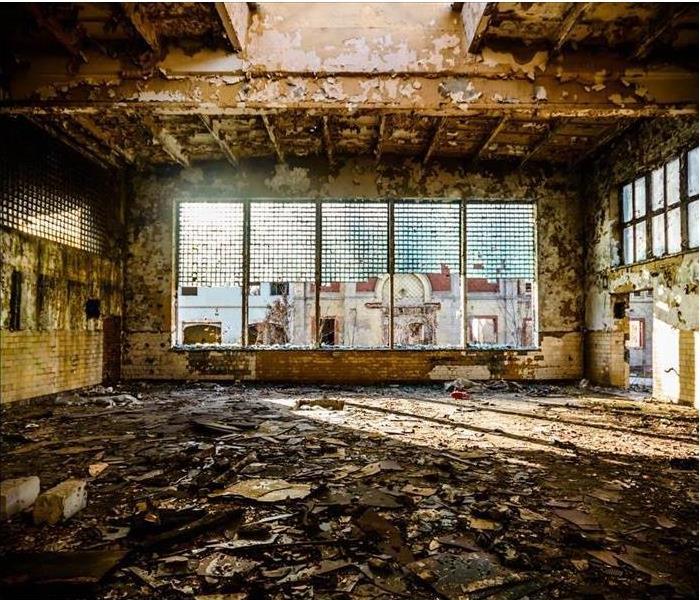 Understand the causes of water damage and minimize damage in your Pueblo, CO property.
Understand the causes of water damage and minimize damage in your Pueblo, CO property.
Water damage caused by a pipe burst, flood, or storm is a common challenge for homeowners. The more you know about water damage, the better equipped you will be to deal with it if it occurs in your home.
What You Should Know About Flooding and Other Water Damage
About one in 50 homeowners file a claim related to freezing or water damage every year. These are some of the most important facts to know about this common problem.
- The Longer You Wait, the More Damage You Will Have
It is critical to dry out wet property within 24 to 48 hours. After this point, mold may begin to grow. Wood may rot. Water from clean sources, such as a water line break, may become contaminated. Quickly and completely drying property is the best way to reduce the total amount of damage done. If you are unable to dry out your property yourself, you may want to contact a water remediation company in Pueblo, CO, to assist you.
- Water Damage Is Often Avoidable
You can't control the weather, but you can often take steps to mitigate potential flood damage by installing a flood control system in your home, keeping your roof and windows up-to-date and in good repair, and making changes to your landscaping. Additionally, you can avoid water damage from broken plumbing or appliances with regular inspections and maintenance.
- Some Water Damaged Property Can Be Restored
Some water-damaged items, such as food, carpet pads, drywall, and other difficult-to-dry or decontaminate items need to be replaced. However, other materials can be dried out and restored if you act quickly.
- It May Be Covered By Insurance
Most homeowners' policies cover water damage from a sudden and accidental discharge, such as that from a pipe burst. Water that enters through an opening in the roof caused by wind damage may also be covered. Flood damage is usually excluded from homeowners' policies, but may be covered if you have a separate flood policy.
- Some Types of Water Damage Are Not Do-It-Yourself Projects
A small amount of water from a supply line leak or a washing machine overflow may be safe to clean up on your own. However, water from flooding or that contains sewage or other contaminants requires protective gear and training that most homeowners do not have.
- Avoid Walking or Driving in Floodwater
Walking or driving in floodwater is hazardous for multiple reasons. First, it can be difficult to judge how deep floodwater is or how swiftly it is moving. People and vehicles can easily be swept away by water they thought was safe. Second, floodwater may contain sewage and other contaminants. Third, the storms that cause flooding often result in downed power lines, which can make walking through floodwater an electrocution hazard. Similarly, water that covers electrical outlets in a home may not be safe.
Most homeowners will encounter some type of water damage. Educating yourself on facts about water damage from a pipe burst or other source can help you stay safe and minimize property damage.
3 Examples of Category 3, or Black Water, Damage
6/17/2022 (Permalink)
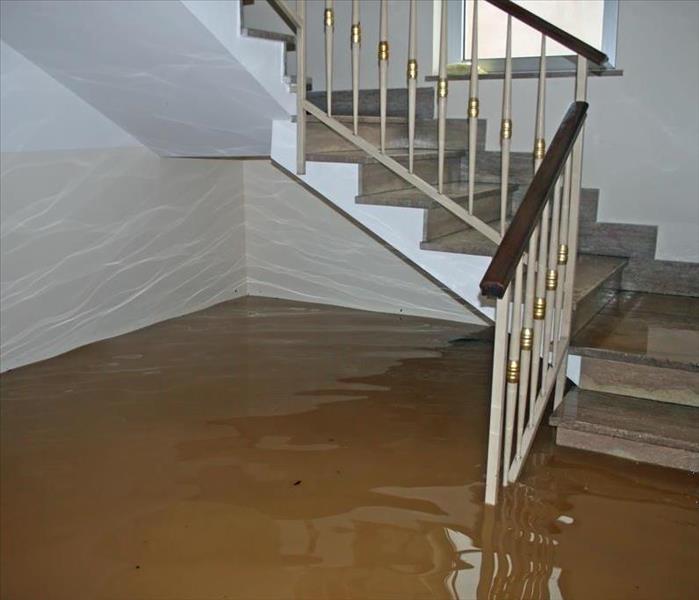 Learn More about Water Damage following our Tips.
Learn More about Water Damage following our Tips.
Water damage happens in many ways and can range from inconvenient, such as a warped countertop, to severe, such as multi-story flooding. It's understandable that in some cases the damage can be addressed by the homeowner, but in other situations, such as black water contamination, the damage requires the services of sewage cleanup experts. As a homeowner in Pueblo, CO, here's what you need to know about this extreme water contamination.
3 Examples of Category 3, or Black Water, Damage
The hazards you can expect from the three categories of water damage range from Category 1 water damage that originates from clean water to Category 3 which contains toxic substances, such as bacteria, pesticides, chemicals, and raw sewage. This type of contamination leads to extensive damage and risk. It can also happen in a variety of situations.
1. Outside Flooding
Storms and heavy rain may cause nearby lakes and rivers to flood. It can raise the water table, leading to flooded basements and ground-level homes. When this happens, the rising water carries feces from rodents and neighborhood pets. It also picks up chemicals from pesticides, garbage, and landscaping treatments.
When this contaminated water flows through your home, those toxic substances are readily absorbed by the structural components of your home as well as by your furnishings and belongings.
2. Sewer Backups
There are several potential causes of sewer backups: clogged and blocked sewer pipes, damaged and aging pipes, tree roots in the system, and major blockage in the municipal lines. As soon as sewage emerges from your toilet, bathtub drain, or sink drain, it's important to reduce the risk to you, your family, and your home.
Don't touch the dirty water and close off the area, so pets, children, and other adults don't move in and out of the area. As water evaporates, many of the chemicals and contaminants from the water will get into the air.
It's important that professionals resolve this situation as quickly as possible. Water damage cleanup and restoration pros have the proper protective equipment and commercial cleaners to remove heavy metals, pesticides, bacteria, chemicals, urine, and raw sewage safely and thoroughly from your home. These technicians have extensive training to protect them and your home from the hazards carried by this contaminated water.
3. Standing Clean Water Flooding
Flooding in your home may originate from a source of clean water. Maybe the bathtub was left running and overflowed. A pipe under the kitchen sink may burst, or a damaged clothes dryer could cause flooding. Initially, this water damage falls into Category 1 and Category 2 contamination, but when that water is allowed to sit for more than 24 hours, the damage will increase until you have black water contamination. This happens because the sitting water absorbs chemicals from the drywall, carpeting, and other materials.
Black water, or Category 3, damage is the most dangerous type of water contamination and should only be cleaned up by professionals with the appropriate protective gear, equipment, and treatments. Your top priority should be ensuring the safety of your family and reducing damage to your home.
We Have a 6-Step Process for Water Restoration
4/8/2022 (Permalink)
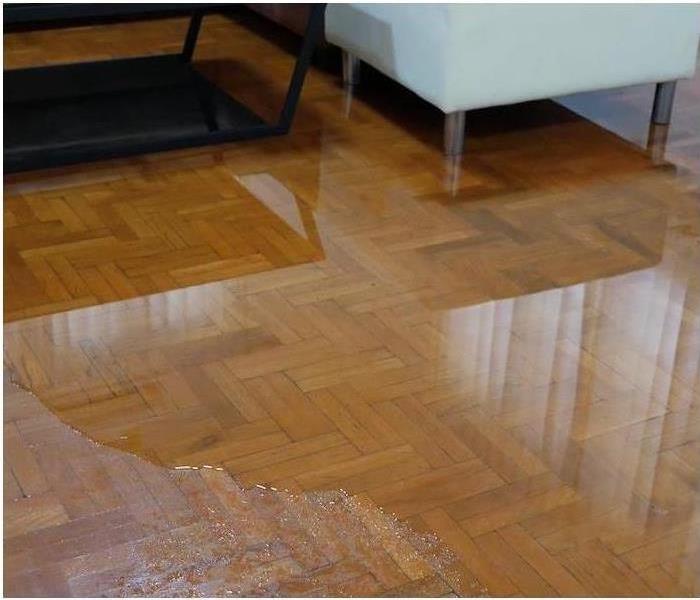 Learn more about the Water Restoration Process by following these tips.
Learn more about the Water Restoration Process by following these tips.
Discovering that you have sustained water damage in your Pueblo, CO property is not enjoyable, but it is important to act quickly if it happens to you.
When you choose us for restoration, you can rest assured that you will receive an answer no matter when you call and that we will set our six-step process in motion. Here’s how we do it:
6 Steps to Water Damage Restoration
- Initial Emergency Contact
Water damage could strike any home at any time, which is why we are always at the ready. When you call us to report damage, we will always answer and gather all the details we can about your damage situation to craft a comprehensive response plan and get to you soon.
- Inspection and Damage Assessment
Inspecting the area for safety hazards and additional leaks is what we do first when we arrive on the scene. Once things are secured, we will do a full inspection to understand the scope of the damage and create your custom action plan for restoration.
- Moisture Extraction
Pulling out standing moisture from the impacted area is key to decreasing the overall restoration time, which is why we have ample amounts of equipment to do so. We will work tirelessly to vacuum and pump out all the water we can before moving onto more fine-tuned methods.
- Dehumidifying and Drying
Following the removal of standing moisture, we will then begin to extract water from the air and impacted surfaces. We will dehumidify and dry all impacted areas completely so they do not continue to deteriorate due to the water damage and to prevent them from becoming vessels for mold growth.
- Cleaning Belongings
The proper sanitizing and deodorizing of items that are affected is important to keep your home free of contaminants and odors in the future. We will fully treat the belongings that have been exposed to the water damage so you can be certain that they are safe to use.
- Restoration and Repair
You can count on us for a complete restoration process, which means we will even apply the finishing touches your job requires. We can apply paint or replace carpets to make the area feel exactly as it did before any water damage ever impacted it.
If your home has been water-damaged, you can count on us to help. Call us 24⁄7 to get the process started.
Taking the First Steps Toward Flood Recovery | SERVPRO® of Pueblo
3/8/2022 (Permalink)
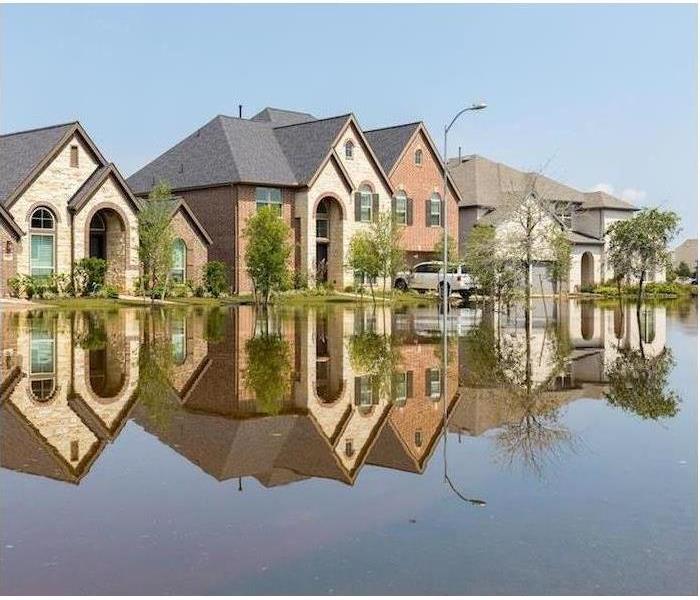 If you’re experiencing any Water Damage from flooding, Follow these Tips and if you have more doubts, contact us.
If you’re experiencing any Water Damage from flooding, Follow these Tips and if you have more doubts, contact us.
Having your home damaged in a flood is a devastating experience, and a quick post-flood recovery is generally the top priority for those affected.
While it is understandable that this is important, it is also essential to be sure you are taking the right first steps and prioritizing your safety during the process. By making yourself aware of what steps to take, you can better prepare for and react to a flooding event in your area.
The First Steps for Flood Recovery
Avoid further safety hazards.
It is logical to want to immediately return home and get to work after a flood, but waiting for local officials to deem it safe is essential. Floodwaters can hide many lurking dangers, and returning to impacted areas prematurely can expose you to many hazards you may not be aware of.
Air out the home.
In addition to the damage from the flood specifically, impacted homeowners must also deal with the possibility of mold growth in their homes. Mold is an airborne fungus, and it thrives in areas that are moist with stale air. Circulating fresh air through your house is a good preventative for this—while it will not stop the growth entirely, it can significantly reduce it and make the air healthier to breathe as you begin the cleanup.
Document the damages.
Most homeowners want to start their cleanup process right away in a flood’s aftermath, but it is important to do your due diligence in the documentation before you begin removing items or cleaning up. Take ample photos of every room that has been impacted and make a detailed inventory list of all the items that have been damaged before you get started.
Contact your restoration and insurance companies right away.
If you have purchased flood insurance for your home, you will want to start the process of filing a claim right away to expedite it. Another thing to expedite is the restoration—leaving flood damage untreated can cause it to get worse, so call your restoration company right away after you discover the damage.
If your Pueblo, CO home has been damaged in a flood, we are here for you. You can contact us 24/7 to receive a quick response and set the restoration process in motion.
Ways to Protect Your Home From Water Damage
12/20/2021 (Permalink)
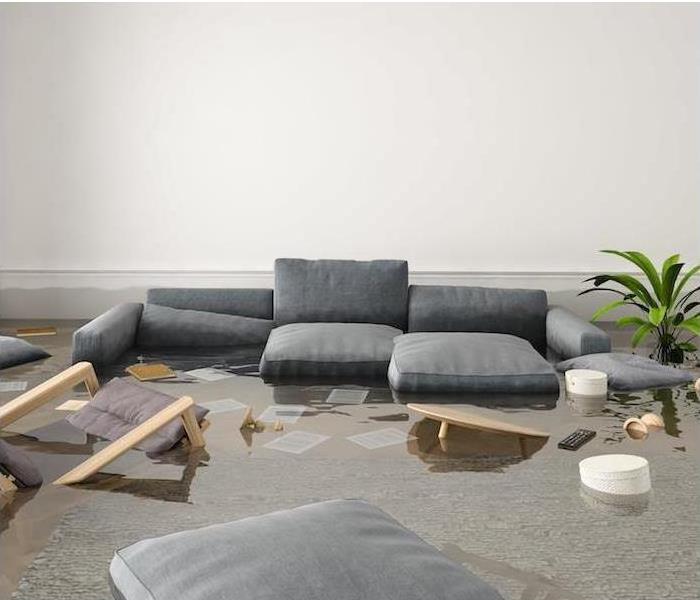 Water damage can be a disaster. Call us to help you recover your Pueblo, CO home.
Water damage can be a disaster. Call us to help you recover your Pueblo, CO home.
Water damage is one of the most common and costliest disasters you may experience as a homeowner. Pipes bursting, dishwashers malfunctioning, washing machines overflowing or storm damage are just a few of the many ways water damage could strike your home.
There are plenty of ways you can protect your Pueblo, CO home from this common issue homeowners deal with. Let’s take a look at some.
How to Protect Your Home
Not only will water damage be a hassle to deal with, but it could quite possibly have a long-term impact on your home if cleanup is not done properly. Mold will begin to grow within 24–48 hours after moisture exposure and is one of the most common side effects of water damage.
When you begin to look for ways to protect your home, it may help you to break it down by areas of impact. These areas might include the basement, kitchen, bathroom, flooring, and ceilings.
Basement
You can help prevent water damage in the basement by preventing water seepage. This can be done by resealing vulnerable areas of the basement, making sure water drains away from your home, and installing a backwater valve.
Kitchen and Bathrooms
Your kitchen and bathrooms can experience water damage due to plumbing issues and appliance failures. Take some time and follow these recommendations:
- Inspect all appliances regularly, especially paying attention to hoses and faucets
- Check all seals and caulking around showers and tubs to ensure there is no leakage
- Know where your home’s main shut-off valve is located
- Be sure that you don’t leave the house while the washing machine or dishwasher are running
How to Recover Your Items
There are things you can do to protect the possessions in your home from water damage, but don’t be surprised if it is not always possible. Use waterproof bins to store items and keep items stored on shelves off of the floor—which is especially recommended when using your basement for storage.
You’ll need to contact your insurance company immediately, evaluate the extent of the water damage in your home, and identify the type of water that is involved.
Types of water to be aware of are:
- Clean water. Can be from rain, condensation, leaky pipes, etc.
- Gray water. Slightly dirty water from dishwashers, washing machines, clean toilets, etc.
- Black water. This water can cause serious health problems and is water from sewage or serious flooding from nearby rivers, etc.
You will need to remove all wet objects, dehumidify and dry your home out quickly after a water damage disaster, and disinfect any remaining materials.
The pros suggest that you freeze wet books, photos, and papers in a frost-free freezer to buy some extra time and prevent mold and mildew from developing and causing further deterioration. Once able, you can remove them from the freezer and air-dry or fan-dry the pages.
It may seem like recovering from water damage is an overwhelming and slightly impossible task, but it doesn’t have to be. You can call on the highly trained experts at SERVPRO of Pueblo, who are here to make it "Like it never even happened."
What Category of Water Damage Is a Broken Pipe?
10/22/2021 (Permalink)
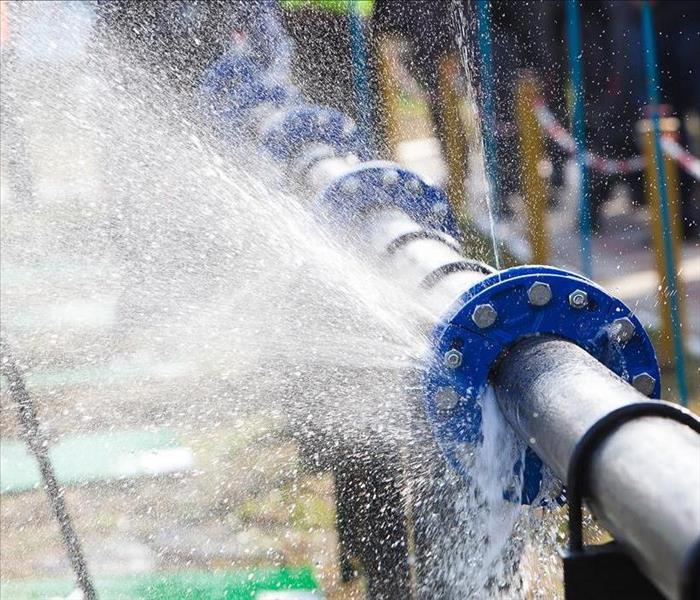 The cleanup of your flooded building in Pueblo, CO, will depend on the category of water.
The cleanup of your flooded building in Pueblo, CO, will depend on the category of water.
Water damage can be tricky to deal with regardless of the source of the water. However, some types of water damage are more difficult to contend with than others. If you have water damage due to a pipe that needs water pipe repair, you may be wondering what category of water damage you have.
3 Categories of Water Damage in a Flooded Building
There are three categories of water damage. Water is classified according to the source and its exposure to contaminants.
1. Category 1 Water
Category 1 water damage is usually the easiest to deal with because it does not contain contaminants. Clean water from a broken pipe or supply line, an overflow from a sink or bathtub with no contaminants, leaking appliances, water from a toilet tank, rainwater, and melting ice or snow are in this category. Additionally, an overflow from a toilet bowl that contains only clean water is in this category. Most instances of water from a pipe that needs water pipe repair are Category 1 water.
2. Category 2 Water
Category 2 water is also known as gray water. This water contains chemicals or biological or physical contamination. This category is more difficult to deal with than Category 1 because anyone attempting to remove it needs to wear protective gear and surfaces that have come in contact with the water need to be disinfected. Examples of Category 2 water include leaks from washing machines or dishwashers, sump pump failures, chilled or condensate water, water from sprinkler systems, and overflows from toilets that contain urine, but no feces. Additionally, Category 1 water that has been left standing for too long or has flowed through building materials from a higher level in the building can become Category 2. As an example, a leak from a clean sink on the second floor of the building would be Category 1 on the second floor, but Category 2 if the water seeps through the floor, ceiling, or walls to get to the first floor.
3. Category 3 Water
Category 3 water is also called black water and is water that is considered grossly unsanitary. This is the most difficult type of water to deal with because it requires specialized safety equipment and training to remove it safely. Unless you have people on staff with this type of training, it is usually best to contact a water remediation company in Pueblo, CO, to remove this type of water. Examples of Category 3 water include water from a sewage system, rising water from rivers or streams, and rainwater mixed with sewage. Additionally, Category 2 water that has not been cleaned correctly can become Category 3. It is important to clean up any kind of water damage within 24 to 48 hours whenever possible.
Water damage from a pipe that needs water pipe repair is usually among the easiest types of water damage to clean. However, it is important to clean it up promptly or it can become contaminated. Additionally, any type of water damage needs to be dealt with as soon as possible to avoid the potential for further property damage.
Causes of Water Damage in Your Home | SERVPRO® of Pueblo
9/7/2021 (Permalink)
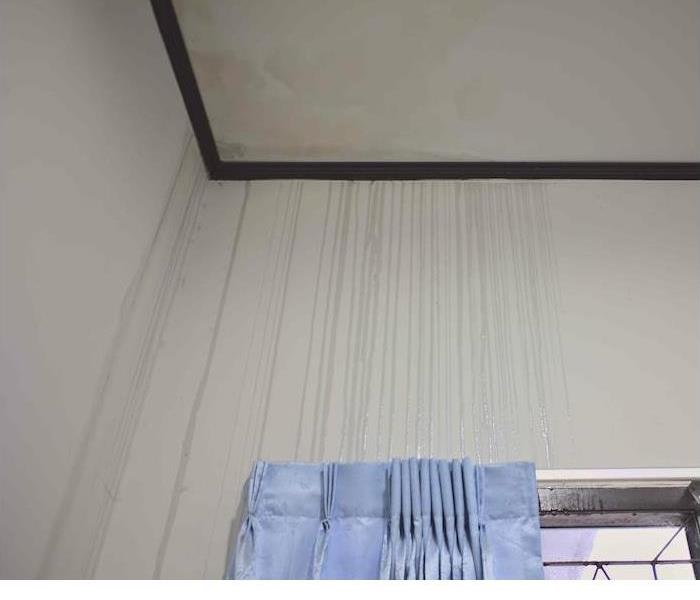 A water leak can turn into a big problem. Contact the SERVPRO of Pueblo team if you are dealing with any water damage.
A water leak can turn into a big problem. Contact the SERVPRO of Pueblo team if you are dealing with any water damage.
When you have water damage in your home, your mind starts racing and you have no idea where to begin with the cleanup. With water, it seems that it can always find its way into your home, through any open crack or crevice.
Being prepared can save you both time and money in the long run. By being proactive and prepping your home or staying on top of maintenance, you can possibly reduce your risk of being affected.
Let’s look at some common causes water damage—in other words, where you should look!
Toilets. Toilets can easily leak or overflow, and that can be quite disgusting. Beyond the ick factor, whether it results from problems with the toilet seals or cracks in the tank or pipes, the water damage can be quite substantial.
Appliances. These luxury items, like dishwashers and washing machines, help make our world a little easier to live in. But like most things, it doesn’t come without a chance of problems. Because many appliances need a source of water, it’s common for them to leak. This often occurs because of the corrosion that can occur on metal items. With a water heater, this degrading of metal can even cause an explosion.
HVAC units. AC is an essential in many parts of the country during the steamy summer months. But the AC can also spring leaks. It’s important to have it inspected and cleaned on a regular basis.
Pipes. When it comes to the plumbing in your home, what can seem like a small leak can quickly turn into a flooding of your home. Whether it’s from old pipes that finally gave way or weather that has caused your pipes to thaw or bust, the water damage can start in your walls without you ever even knowing it. Tree roots are also a common cause of pipe problems that develop into leaks.
Clogged gutters. Gutters perform an essential function, helping water drain efficiently from the roof of your home, which can help prevent leaks in the ceiling or walls. Inspect the gutters regularly and after storms, and remove any debris found inside to clear a pathway for water.
Maintaining your appliances, roof or pipes can not only help protect your home from disasters, but it will also help your things have a longer life. Some simple actions can save some big money.
If a water leak erupts into a big problem at home, you’ve got the best team in the business on your side. Contact SERVPRO today so we can get started.
Common Indicators of Basement Water Damage | SERVPRO® of Pueblo
5/21/2021 (Permalink)
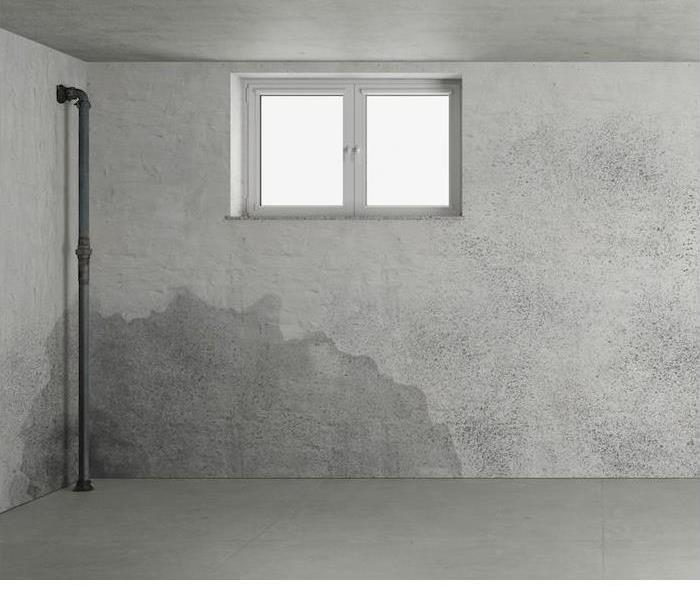 SERVPRO of Pueblo is a full restoration company. Our team of experts are on call and ready to help you determine the best course of action.
SERVPRO of Pueblo is a full restoration company. Our team of experts are on call and ready to help you determine the best course of action.
The basement is a favorite room of the house for many homeowners and families. It can be spacious for storage, cozy for living or playing or safe for sheltering in a storm.
But because basements are dug into the soil around your home, they often fall prey to moisture leakage, not to mention they become the fall-guy areas for other leaks in the home from plumbing, water heaters and the like.
While there’s certainly no guarantee that you’ll have to deal with water damage in your lower level, the odds are high enough that you should definitely be aware of what to look for. These indicators will let you know that water is coming in from somewhere—and when you see them, your local SERVPRO technicians are awaiting your call.
The Top Indicators of Water Damage in a Basement
Unpleasant, musky odors. Even if water that gets into the basement is clean, whether it comes from rainfall or a burst pipe, it doesn’t take long for it to develop bacteria, which turns into mold on your home surfaces and emits the musty, malodorous smell often associated with basements. This smell shouldn’t be the norm—it only arises when mold and mildew are present in the environment, and even if you can’t yet see mold, the smell lets you know you’ve got a water issue to manage.
Flaking paint on masonry or walls. Homeowners sometimes apply so-labeled waterproof paint to their basement interiors, thinking its one-application solution to lock out moisture. While it can help for a while, if a leak is happening behind it, even the thickest paint is going to eventually give way and let the water through. When you see bubbling, cracking and flaking in your paint job, there’s water to be found somewhere.
Foundational cracks. Homes may shift over time, but a crack in the foundation can’t be ignored, and it may be indicative of a serious water leak. On the inside, cracks may show up in the floor, the ceiling or in your walls, telling you that your house’s frame may be succumbing to undue pressure caused by a cracked foundation. There’s no need to worry about minute, hairline-type cracks, but anything larger requires professional help.
If you notice any of these signs in your basement, let us take a look. Our expert water restoration technicians can help you determine what is causing these issues and how to treat it properly. Contact us today to learn more.
Copyright © 2021 SERVPRO of Pueblo
Take the Right Steps to Stop Rain From Damaging Your Home | SERVPRO® of Pueblo
4/5/2021 (Permalink)
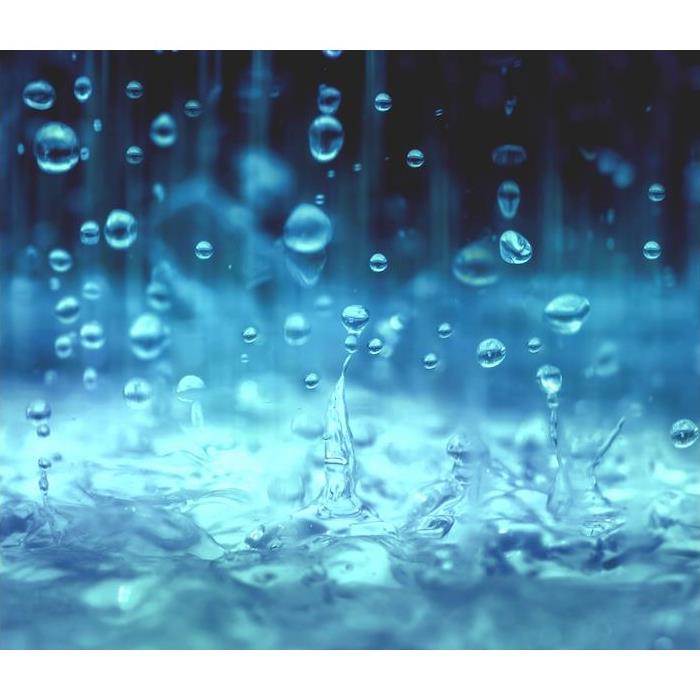 If you need help dealing with any damage caused by water, contact SERVPRO of Pueblo today.
If you need help dealing with any damage caused by water, contact SERVPRO of Pueblo today.
If you were asked about the most common reasons homeowners had to file water damage claims on their insurance, what would you say?
The most common guesses include damage from storms or floods. Right behind those causes are problems with items in the home, like the plumbing or the sewer.
The reality is that water damage can come from many places.
Homeowners cite a variety of problems when they file water damage claims, including things like severe floods and storms or from problems in the home, like a burst pipe.
Just how common is water damage? Insurance industry experts speculate that as many as one in every 50 American homeowners will file a water damage claim this year.
So if you have to file a claim for water damage this year, you’ll have a lot of company. Statistically, it’s like that someone you know will have to file a water damage claim this year, too.
Preparing Your Home and Family for Wet Weather
Our staff includes a dedicated team of water damage experts, so we have valuable insights into how you can protect your home from suffering water damage now and in the future. The good news is that basic home maintenance can help you stay safe from water damage.
Spend time understanding how drainage can impact your yard. The next time it rains, take a look at your yard. If the water from the rainstorm is draining toward your home, you might have a problem. You might want to connect with a landscaping expert to look for ways to protect your yard.
Use your landscaping as an extra layer of protection. Protective landscaping is real, and you can get it closer to home than you might think. It’s smart to use native plants to add more water protection to your home. Talk to a local expert about native plants or visit a native plant sale.
Seal your roof. According to insurance industry statistics, 95% of damage is caused by water finding its way through gaps in your shingles, which can be prevented with this step. It’s definitely worth considering.
If you need help dealing with damage caused by water, fire or any other issue, we’re here to help you restore your home. We have crews who are available 24⁄7 in the event of an emergency. Contact us at any time to learn more about us and how we can help you restore your home to its original state.
Signs to Look for When You’re Dealing With Water Damage | SERVPRO® of Pueblo
1/13/2021 (Permalink)
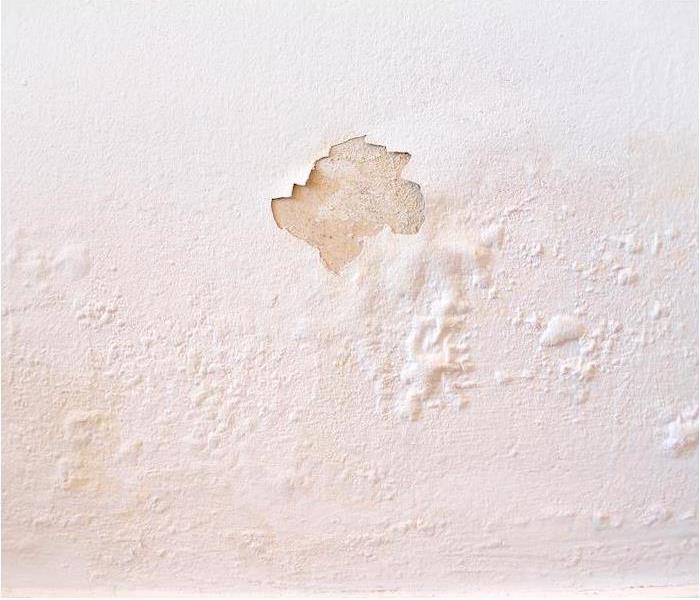 Do you have any water damage to your walls or ceiling? Contact SERVPRO of Pueblo, we will help guide you through the restoration process.
Do you have any water damage to your walls or ceiling? Contact SERVPRO of Pueblo, we will help guide you through the restoration process.
Water damage is a common headache for homeowners. In fact, one out of every 50 American homeowners files a water damage claim on their homes every year.
That’s not just because there are more of all types of claims being filed, either. Other types of claims have been falling in recent years. Water damage claims are growing annually, while claims for fire damage have been falling.
When to Consider Reaching Out for Help
If you’re an Avondale homeowner, you may be wondering when you could need water damage restoration help. Your local SERVPRO team can help answer your questions. And if you need restoration work, we can create a custom damage report for you.
You might notice these signs if you’re dealing with water damage that needs to be evaluated by water remediation specialists:
Fabric upholstery or curtains start to bleed or fade. Contact with water can cause certain fabrics to stain, bleed or fade. If you notice that happening to your drapes or your upholstered furniture, take notice. It can be a sign of water damage.
Wood in your home is starting to warp. Items made of wood can show damage from water only a few days after exposure. So timing is essential if you start to notice wood warping or staining. Call a water remediation technician immediately.
Signs of mold start becoming obvious. Musty odors are among the first signs of mold and mildew. So if you notice that distinctive scent, it’s important to move fast and begin the remediation process. Mold only worsens over time.
If you have water damage in your home due to a burst pipe or another cause, you can count on us for restoration assistance. We have teams who are available 24⁄7 in the event of an emergency. Contact us at any time to learn more about our restoration services.





 24/7 Emergency Service
24/7 Emergency Service













